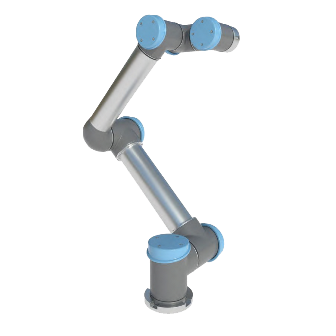Industrial robots have had an increasing role in the automation of metal fabrication. While larger, articulated robots are the most common for automating the metals industry, collaborative robots are beginning to also emerge for metal fabrication processes such as stamping.
Metal stamping involves creating specific designs or shapes on metal workpieces. As mentioned above, larger robots like the FANUC R-2000ib are common for automating stamping applications. However, collaborative robots have become a strong alternative for stamping automation. The Universal UR5 and other cobots have a lower cost of ownership than traditional industrial robot arms. Collaborative robots are typically more affordable to buy than other robot manipulators. Their lower cost makes them more accessible to more manufacturers. The affordability of collaborative robot automation has become crucial for manufacturers as they look to combat growing labor shortages. The FANUC CR-15ia can fill in labor gaps and help boost production.
How Collaborative Robots Automate Stamping
Collaborative robots are ideal for tending stamping presses. Their small size allows them to easily be installed next to presses. In addition, they do not require extra safety equipment, which means they need minimal space and can easily operate around other machines. They can load, unload, and operate presses. However, they are limited to handling smaller and lighter parts due to their reach and payload restrictions. The FANUC CR-35ia currently is the heaviest payload cobot at 35 kg. Other cobots have payloads under 20 kg.Cobots may also automate the removal of excess material from workpieces post stamping. This may involve trimming, deburring, or grinding away unwanted material produced during the stamping process. Collaborative robots can also be integrated with a vision system to automate the quality control aspect of metal stamping. Robotic vision systems allow collaborative robots to thoroughly inspect workpieces for any flaws or defects before further processing, ensuring high quality products.
How Collaborative Robots Improve Stamping Applications
- • Shorter Changeovers - One of the biggest advantages of collaborative robots is their short changeover times. When processes or workpieces change they can be quickly reprogrammed and redeployed with their hand guidance programming. Changeovers occur in a matter of minutes as opposed to several hours.
- • Increased Flexiblity - Collaborative robotic manipulators are highly adaptable which increases manufacturing flexibility. They can be quickly retasked with their intuitive programming. The KUKA lbr iiwa 14 R820 can tend press machines and then be reprogrammed for inspection. Their size and light mass allows them to be easily relocated to fill in where needed.
- • Increased Productivity - Collaborative industrial robot arms are ideal for automating repetitive tasks such as loading and unloading presses, operating presses, and quality control. Workers are relieved from undesirable jobs to focus on more critical and value adding ones. This in turn helps increase productivity. Studies have shown factory robots can increase productivity rates by up to 85%.
- • Improve Quality - Automating stamping with collaborative robots will improve quality by reducing errors. When humans perform repetitive tasks they can easily lose concentration allowing for errors to occur. Six axis robot are accurate and excel at repetitive processes. Parts will always be correctly loaded and positioned in press machines, preventing errors and scrap. Using manufacturing robot arms for inspection provides accurate and fast feedback which also helps to lower scrap and error rates.
